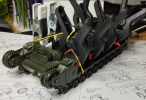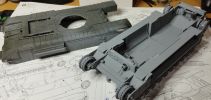Andy T
SMF Supporter
Personal preference with the painting vs building. I prefer to paint the wheels and tracks separately whenever possible as they may want different colours, finishes or weathering effects.
As for the mould line, scraping along it usually removes the majority, if not all. You can get dedicated mould line removers, or scrapers, but I find the back of a hobby blade, or even the sharp side, works well enough.
If there is a tiny bit left that you just can't reach to sand, some carful brushing with an extra thin cement will melt it and blend it in.
As for the mould line, scraping along it usually removes the majority, if not all. You can get dedicated mould line removers, or scrapers, but I find the back of a hobby blade, or even the sharp side, works well enough.
If there is a tiny bit left that you just can't reach to sand, some carful brushing with an extra thin cement will melt it and blend it in.


 However, my take on it is that, if something gets in the way for painting, it’s probably best to leave it off until afterward. On a Churchill, I would put the drive sprockets and idler wheels in already, but leave them loose (so you can rotate them to paint them all over), but only fit the roadwheels after painting both the suspension and the wheels themselves.
However, my take on it is that, if something gets in the way for painting, it’s probably best to leave it off until afterward. On a Churchill, I would put the drive sprockets and idler wheels in already, but leave them loose (so you can rotate them to paint them all over), but only fit the roadwheels after painting both the suspension and the wheels themselves.
 Elastic band AND clamps, now that's just showing off!!!
Elastic band AND clamps, now that's just showing off!!!
